Saffron risotto with peas and goat cheese makes a real dinner party showstopper. But it's super-easy and ready in about 30 minutes, so you can make it on a weeknight, too.
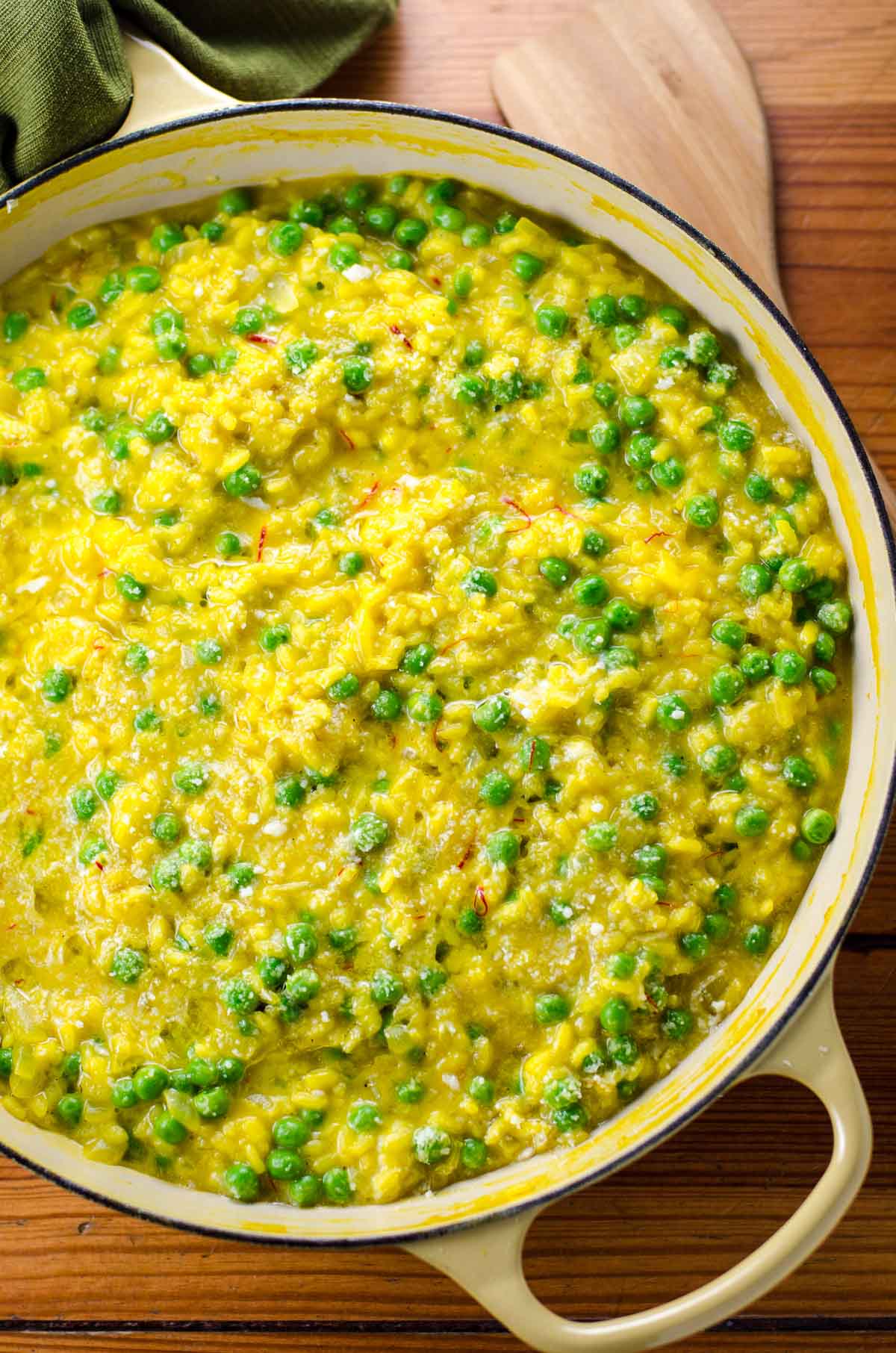
Why we love this recipe
I love this saffron risotto recipe, partly because it’s super-delicious and partly because I think it represents the essence of my cooking style pretty well. I basically start with every intention of hewing to a traditional recipe — in this case Risotto Milanese — and then am like, okay but let’s throw in some peas and goat cheese, because more is more!
And something new is born in our kitchen that makes us very happy, but with a little cognitive dissonance about the likelihood that Lidia Bastianich and Marcella Hazan may be off in a corner somewhere weeping and/or conspiring to murder me.
I hear you’re supposed to have an elevator pitch for your blog and the cooking style it represents. I’m having a little trouble fine-tuning mine, can you tell?
I first published this recipe here back in 2016. I've updated the post for clarity, but the recipe remains the same.
What you'll need
Here's a glance at the ingredients you'll need to make this recipe.
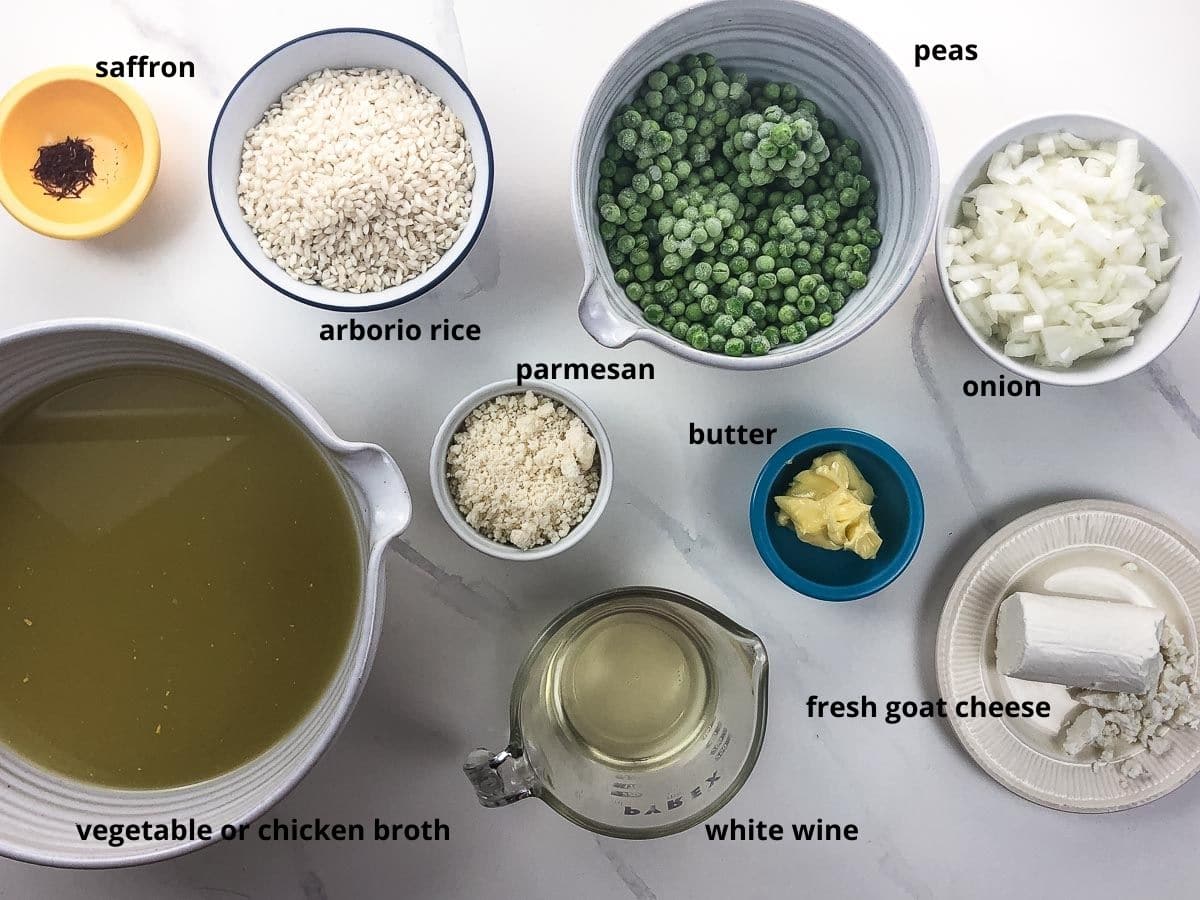
- Arborio rice is an Italian short-grain variety of rice. Its high starch content helps create the risotto's silky, creamy broth. And its superior quality means the grains retain their al dente bite amidst the creaminess. Alternatively, you can use carnaroli rice. It works similarly but has a slightly longer grain, higher starch content, and firmer texture.
- Saffron has a reputation for being extremely expensive. While that's technically true, it's so light, and you need so little, that the amount you use for a dish like this won't break the bank. The cost comes partly from the labor involved in harvesting it, but this is a complex story in which American sanctions play a big role and have major consequences. Learn more about how to buy saffron here.
- This is a great place to use frozen peas.
- Fresh goat cheese also goes by the name chèvre.
How to make it
Here's what you'll do to make a beautiful batch of saffron risotto. You can see the steps in action in the video that accompanies this post, and get all the details in the recipe card below.
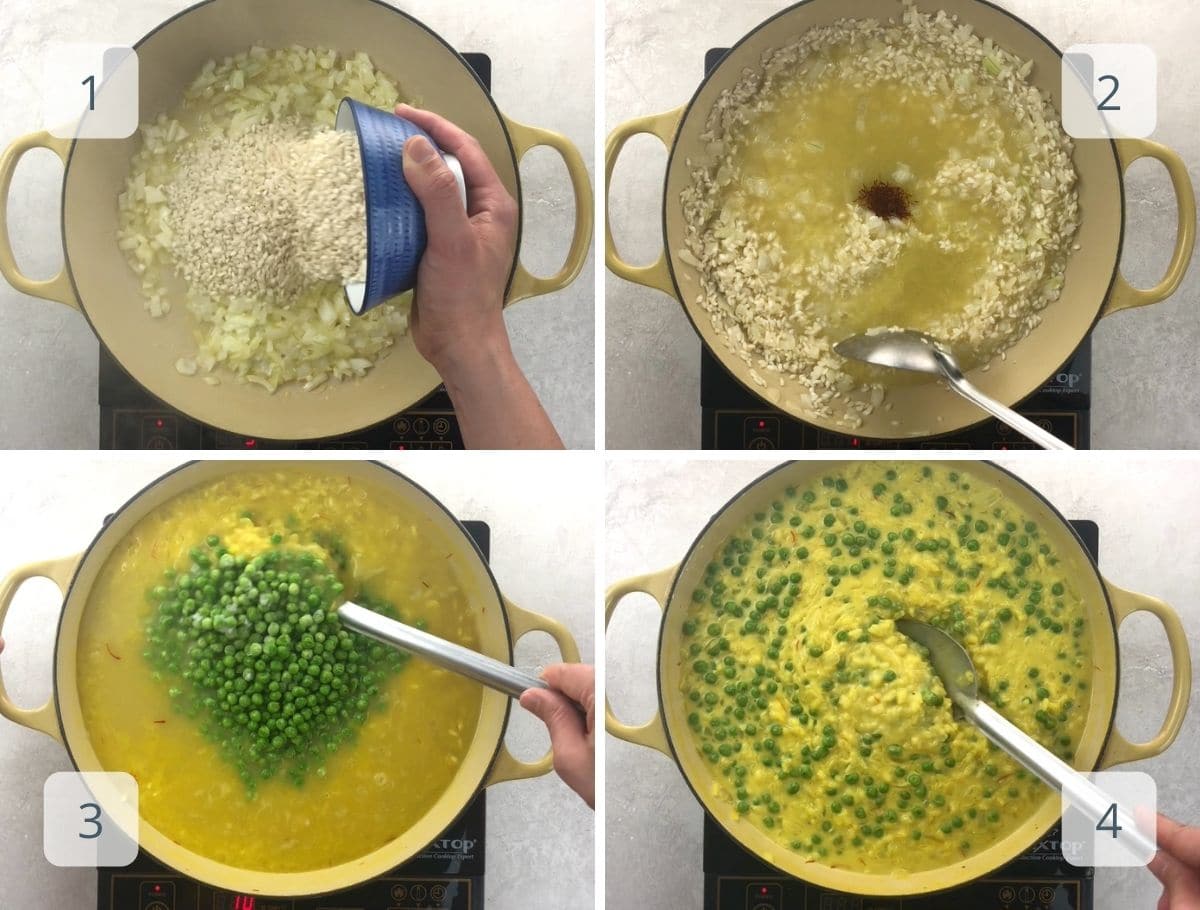
- First you'll sauté the onion and then the rice in the butter. Add the wine and cook, stirring frequently, until it's mostly absorbed.
- Add the saffron with the first pour of broth. Stir frequently, but there's no need to do it constantly. Continue adding broth about a cup at at time until it's all incorporated.
- With the last addition of broth, add the peas. Don't worry if they're still partially frozen. Continue cooking until the rice is tender but with a bit of a bite to it and there's still plenty of starchy broth in the pan. Keep in mind that the broth will thicken up as the risotto cools and rests.
- Off the heat, stir in the cheeses and the pepper. Let rest for five minutes before serving.
Expert tips and FAQs
Blooming saffron by crushing it and letting it sit in hot water (or on an ice cube!) helps coax out its flavor. However, in dishes like this one with plenty of liquid that simmers for a while, I don't find it necessary to bloom the saffron. You're welcome to do so if you like.
I don't know where this myth comes from, but it sure is persistent. I get asked about this all the time. My best guess is that people are drawing on their romantic ideas of Italian nonnas and Italian-American grandmas stirring giant pots of Sunday sauce. Or maybe they're thinking of cooking an intact grain like whole farro, which likes to be soaked overnight and then boiled for at least 45 minutes.
At any rate, the rice used in risotto — whether arborio or carnaroli — is just a short grain variety, stripped of its husk and bran like other white rice, that doesn't take long to cook.
When you stir risotto, the grains of rice bump up against each other. This agitation helps the rice's natural starchiness create a creamy, silky broth. It's good to stir the risotto frequently, both to encourage creaminess and to prevent burning on the bottom of the pan.
But more isn't always better. Too much stirring can start to make things almost gluey. I like to think of it as stirring frequently, but definitely NOT constantly.
More favorite risotto recipes
- Risotto with lemony shrimp and broccoli
- With caramelized onion, spinach, and bacon
- With ham, peas, feta, and tarragon
- Pumpkin and sage
- And if you like risotto but want to kick it up a notch, try this farro recipe, or this one.
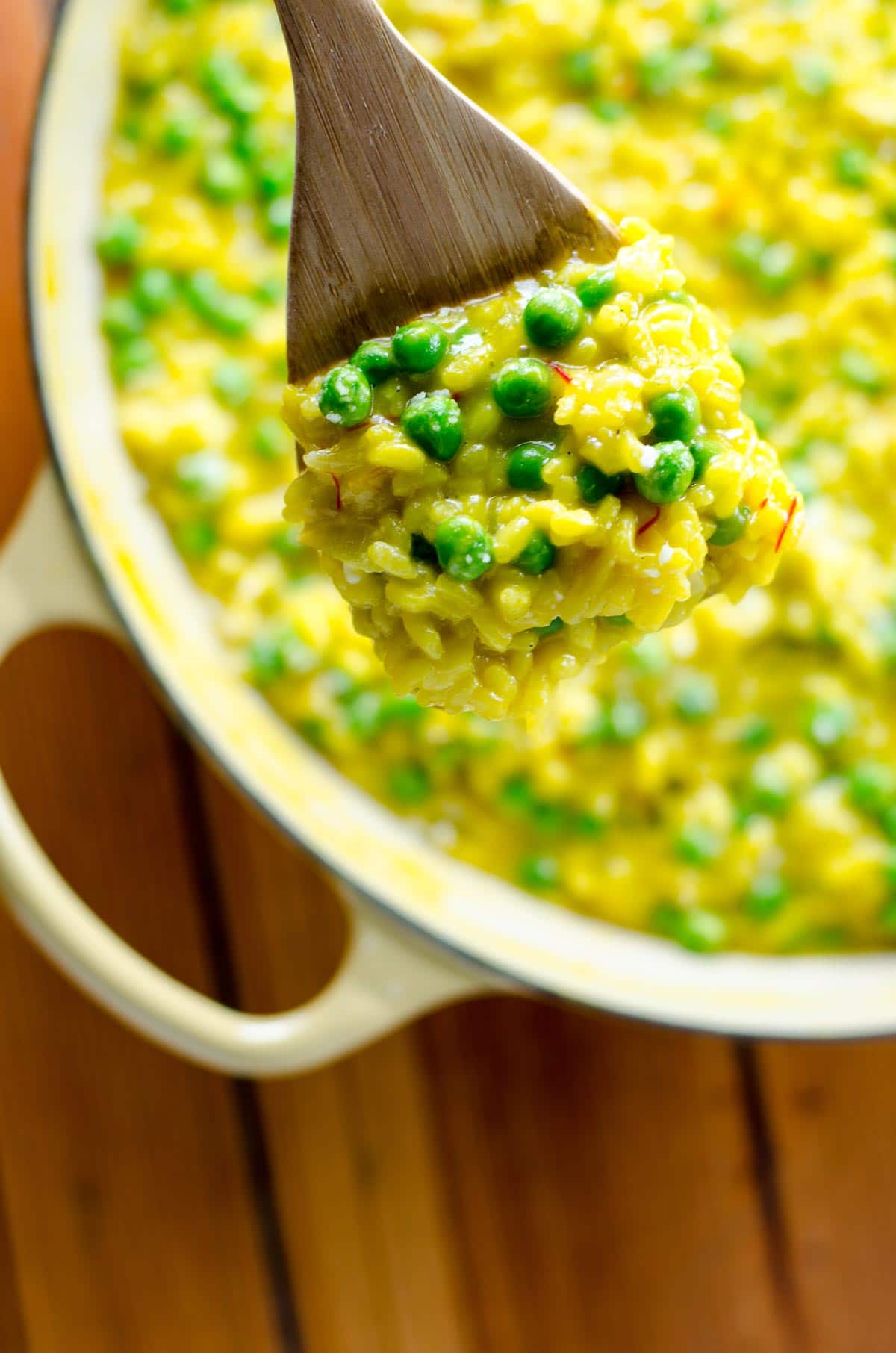
Hungry for more?
Subscribe to Umami Girl's email updates, and follow along on Instagram.

Saffron Risotto with Goat Cheese and Peas
Ingredients
- 3 tablespoons (42 grams) butter
- 1 medium yellow onion (diced small)
- 1 teaspoon fine sea salt
- 1 ½ cups (270 grams) arborio rice
- ½ cup (120 ml) dry white wine
- ¾ teaspoon .5 gram saffron threads
- 5 cups 1(180 ml) good vegetable or chicken broth
- 10 ounces (283 grams) small frozen peas
- 4 ounces (113 grams) fresh goat cheese
- ½ cup (60 grams) grated Pecorino Romano or Parmigiano Reggiano cheese
- ¼ teaspoon freshly ground black pepper
Instructions
- In a large pan with a heavy bottom, melt the butter over medium-high heat.
- Add the onion and the salt and cook, stirring frequently, until beginning to soften, about five minutes.
- Stir in the rice and cook, still stirring frequently, for two minutes.
- Add the wine and cook, stirring frequently, until nearly absorbed. Lower heat to medium if necessary to prevent any hint of burning.
- Begin adding the broth by the cupful (or so), stirring frequently throughout. With the first addition, crumble in the saffron threads. Continue adding broth as the rice absorbs it.
- Stir in the peas with the last addition of broth.
- Risotto is finished cooking when each grain of rice is tender but still has a nice hint of chewy bite, and there's still some delicious starchy broth remaining. Keep in mind that the broth will thicken as it cools.
- Off the heat, stir in the cheeses and the pepper.
- Let the risotto rest for about five minutes before serving.
Notes
- Crumbling in the saffron as the risotto cooks rather than steeping it ahead of time is a little unconventional, so if you like you can steep the threads in a little bit of the broth for 30 minutes or so before adding. In a recipe like this, with plenty of liquid and simmering time, I don't find it makes a bit of difference.
- In fact, please apply this attitude toward your risotto cooking in general. Risotto has a bit of a reputation as challenging to cook, and it shouldn't. The keys are just to stir frequently to release the starch from the rice (you definitely don't need to obsess about stirring constantly) and to quit while you're ahead and there's still plenty of beautiful broth in he pan.
- Risotto's combination of firm-tender rice and creamy broth will be at its best shortly after cooking. I don't recommend making it in advance. If you need to, you can parcook it in advance, proceeding though step 5 but stopping with a couple of cups of broth still to add. Finish right before serving.
- Letftovers will keep in the fridge for about a week. They'll taste great but thicken up a bit, which is fine. You can reheat in the microwave.
Nutrition
Hungry for more?
Subscribe to Umami Girl's email updates, and follow along on Instagram.






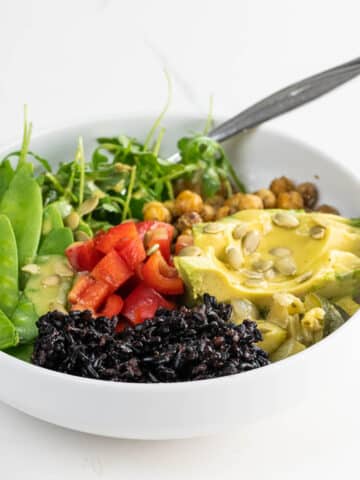


Leave a Reply